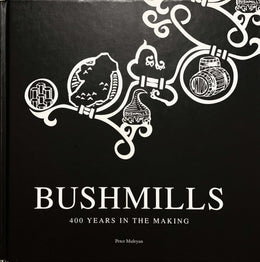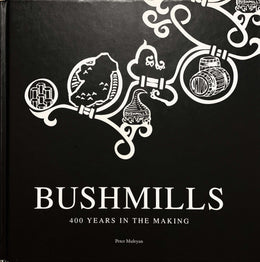
It runs in the family: Billy Chambers' father David worked at Bushmills before him (here filling casks, 1973)
For six people, the 400th anniversary of the licence to distil marked another significant anniversary. For the '1608 Club', it was the year they retired.
These six are typical of generations of workers who have seen so much change. They started their careers working for a family firm and ended as part of the largest drinks company in the world. During their lives at Old Bushmills, the whiskey industry changed beyond recognition, but these were the people who made that change possible. These are the people who help make Old Bushmills great.
In the 1960s whiskey making would only begin late in the year after the barley had been harvested, and would continue until the early summer. However most of the workers were kept on full time. Billy Chambers recalls that during the summer they would do repair jobs around the place.
“I remember we'd paint the place, and one year I was on the roof painting the lettering!"
Needless to say these were the days before Health and Safety forms and hazard assessments.

"Sure it was dangerous," added Billy, "but that's just the way things were in those days."
One of the biggest changes has been in the way people end up working at the distillery. Up until the 1970s people got jobs in the Bushmills distillery under recommendation
“If you knew a lad wanted a job, you'd ask around. See if they were all right," remembers Billy, whose father worked at the distillery, and whose daughter is now the Brand Home Manager.
"But that's nothing unusual: you can get three or four generations of uncles, fathers, sons and daughters working here. I went to work at the distillery for three months," he added, "and ended up staying for 43 years!"
Over the years the distillery has been a great source of employment in an area with little industrial development. As late as the mid-1960s there were 16 coopers at Bushmills and another 3 in Coleraine. A couple of coopers would be started every few years as it took a long time to learn all the skills, such as how to move a 600 kg butt without doing in your back. Nowadays Watson McCook is the distillery's last remaining cooper. Watson has worked at Bushmills all his life, and like so many of his generation, he is due to retire very soon.
With over 200 years' experience between them, there is not much that the 1608 Club have not seen. Ronnie Brennan started working at Coleraine distillery in 1964 and he remained there, on and off until the place finally closed in 1979. In fact Ronnie did the last mash in Coleraine.
"I was sorry to see it close," he said. "But you do your job and get on with it. It was sad, but the move to Old Bushmills suited me. You see I live in Bushmills, and having to drive to Coleraine every day was a real pain!"
Ronnie was also the last person to work the old mash tun in Bushmills. This has since been sliced open and can be seen during the distillery tour.
"I didn't just wear out one mash tun," he laughed. "I wore out two!"
When it comes to not doing things by halves, Ronnie is not alone. Billy Chambers has emptied two distilleries. He picked up the last load of grain whiskey from the closed Coleraine distillery in the 1980s and brought it to the Bushmills warehouses and before that he helped clear out Killowen.

Harry Elliott, maturation foreman, joined bushmills in 1976

Taking a water sample from the distillery dam for analysis in the lab. A bit of science before the magic begins.


'After they sold off Killowen, it would have been the early '70s, I remember filling my truck with the last casks. I had to drive down a one-way street, but I did permission from the police!"
As well as the old damp warehouses of Killowen, warehouse number 7 at Bushmills had a fine reputation for producing exceptional whiskey. It is said, that in warehouse number 2 at Old Bushmills, you can still see the traditional old flooring, and it is a great place to do a whiskey tasting when the spirit is drawn straight from the barrel!
Harry Elliott spent 43 years working in maturation, and who would therefore know a thing or two about ageing spirit. He remembers tasting some of that whiskey. It had matured on the damp floor of the old warehouse. There was no concrete under the casks, just pressed earth.
"Oh, it made for fine whiskey," he remembered. "It would have been malt, it was an old one from Coleraine and perfectly matured. These old warehouses were something special."
Molly Anderson and Bellina McMullen each worked on the bottling line at Bushmills for 34 years. They remembered when the bottling was moved from Coleraine.
"In those days we had to hand label everything," recalled Molly. "We'd put the label on, then hold it up to the light to make sure it was straight."
When the bottling started at Bushmills, Bellina remembers getting to grips with her new job.
“I remember breaking a bottle by mistake and everyone saying it would be taken out of my wages. Then I accidentally broke the glass measure used by the Customs Office and I thought, 'Oh what's that going to cost me!?"'
Things certainly have changed: these days the bottling line is fully automated and every drop of whiskey is electronically accounted for. That was not always the way. There was a time when every employee would queue up at the end of the day for a "wee nip" —a shot of whiskey.
"You'd have to line up for it," said Billy, "but some of the cheeky lads would get their shot, then join the end of the queue and try again. If they were told they had already got their whiskey, they'd reply saying 'No, that was yesterday'!"
Eventually the daily dram was done away with and replaced by a glass of lemonade. That did not go down too well.
"Lemonade is fine," Ronnie recounted dourly, "but only as a mixer!"
After a while the lemonade too was done away with and instead, every now and then, workers would get a wee bottle to take away.
"I recall someone, who will remain nameless..." smiled Billy, "and he shoved the bottle into his back pocket, but then slipped and fell on his backside. When he stood up he felt something wet running down his leg and said, 'I hope that's blood!'"
There have been a lot ofchanges at Old Bushmills over the past four hundred years, yet the more things change, the more they stay the same. In the reception area (where Harry and his pals used to practice bowling) you will find a bottle of Old Bushmills Single Malt. But this is no ordinary Old Bushmills —it dates from 1888 and is the company's oldest surviving bottle.
Not long after his arrival, Master Distiller Colum Egan got a long needle and took a small sample from the bottle and sent it for analysis. This whiskey would have been made during the reign of Queen Victoria, the same whiskey that won Gold at the Paris Exhibition the year the Eiffel Tower was unveiled. Surprisingly, it is pretty much the same ten- year-old malt you can buy today. Perhaps that says all that needs to be said about the consistency of Old Bushmills:
You don't get to be the best because you're the oldest; you get to be the oldest because you are the best.

Watson McCook joined Bushmills as an apprentice cooper in 1966. Bushmills is one of only a few whiskey distilleries to keep an on-site cooperage to this day.

Over 200 years of experience at Bushmills between them (from left to right, top to bottom) the '1608 Club': John Black, Harry Elliott, Ronnie Brennan, Molly Anderson, Billy Chambers, Bellina McMullen

Let's raise a glass…. Colum Egan and Helen Mulholland toast 400 years of Whiskey-making heritage with their new creation, Bushmills 1608.

Written by Peter Mulryan
The text is an excerpt from "Bushmills: 400 Years in the Making" (pp. 140 - 153), written by Peter Mulryan, published 2008 by Appletree Press Ltd.






